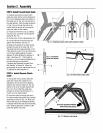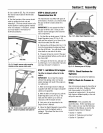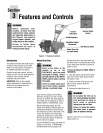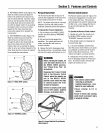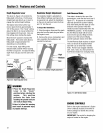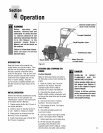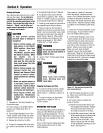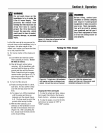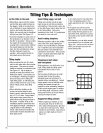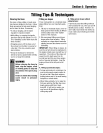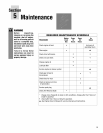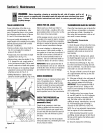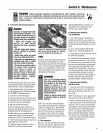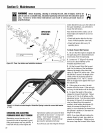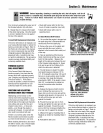
Section4: Operation
16
Tilling Tips& Techniques
Letthetiller dothe work
* While tilling, relax and let thewheels
pull the tiller along whilethe tines do
the digging. Walk on the sidethat is
not yet finished (to avoid making foot-
prints in the freshly tilled soil) and
lightly, but securely grip the handlebar
with just one hand.SeeFigure 4-2.
oAvoid the temptation to push down on
the handlebars in an attempt to force
the tiller to dig deeper. Doing sotakes
the weight off the powered wheels,
causing them to losetraction. Without
the wheels helping to hold the tiller
back,the tines will attempt to propel
the tiller backward toward the
operator- often causingthe tiller to
skip rapidly across the ground.
Tilling depths
• When preparing the soil, till a fresh
path on each passrather than overlap-
ping passes. This gives the wheels
maximum traction on undisturbed soil.
SeeFigure4-6. Dig as deeply as
possible on each pass without over-
loadingthe engine. Later passescan
be overlapped. (Watering the garden
area afew days prior to tilling will
maketilling easier,as will letting the
newly worked soil set for a day or two
before making a final, deeptilling
pass.)
• Whencultivating (breakingupthe
surface soil around plantsto help
destroyweeds), adjustthe tinesto dig
only 1-1/2"to 2" deep. Usingshallow
tilling depths helpspreventinjuryto
plantswhose rootsoftengrow closeto
the surface. If needed,lift up on the
handlebarsslightly to preventthetines
from digging toodeeply. Cultivatingon
a regularbasisnot onlyeliminates
weeds,it also loosensandaeratesthe
soil for bettermoistureabsorptionand
faster plantgrowth.
Avoidtilling soggy,wetsoil
Tilling wet soil often results in large,
hardclumps of soil that can interfere
with planting. If time permits, wait a day
or two after heavyrainsto allow the soil
to dry before tilling. Testsoil by
squeezing it into a ball. If it compresses
too easily, it is too wet to till.
Avoidmakingfootprints
Wheneverpossible, walk on the untilled
side of the unit to avoid makingfoot-
prints inyour freshly tilled or cultivated
soil. Footprintscausesoil compaction
that can hamperroot penetrationand
contribute to soil erosion. Theycan also
"plant" unwantedweed seedsback into
the freshly tilled ground.
Choosingcorrectwheel
andtine speeds
With experience,you will find the "just
right" tilling depth andtilling speed
combination that is bestfor your
garden.
Set the enginethrottle lever at a high
enough speedto give the engine
adequate powerand yet allow itto
operate without overloading it. Fastest
engine speedsmay bedesirable when
makingfinal passesthrough the
seedbed or when cultivating. Selection
of the correct engine speed, in relation
to the tilling depth,will ensure a suffi-
cient power level to do the job without
causing the engineto labor.
Suggestedtilling patterns
• When preparinga seedbed,go over
the same pathtwice inthe first row,
then make individual passesright next
to each other (see Figure4-6). When
finished in one direction, makesecond
passes ata right angle asshown in
Figure 4-7.
In very hardground it may takethree
or four overlapping passesto thor-
oughly pulverizethe soil. (SeeFigure
4-8.)
• If the garden sizewill not permit
lengthwise and then crosswise tilling,
then overlap the first passesby one-
half a tiller width, followed by succes-
sive passesat one-quarter width (see
Figure4-8).
• With planning, you canallow enough
room betweenrows to cultivate (see
Figure4-9). Leaveroom for the hood
width, plus enough extra roomfor
future plant growth.
Figure4-6
Figure 4-7
Figure4-8
%
Figure 4-9



